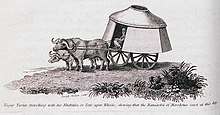Hamaxobii
The Hamaxobii (Ancient Greek: Ἁμαξόβιοι), Anglicized Hamaxobians or Amaxobians, were a nomadic tribe who lived in chariots with leather tents mounted on them.[1] They were Scythians.[2] They were said to be descendants of the Medes.[3]

A drawing of the Turkic version of their carts
They lived near the Palus Maeotis.[4] Claudius Ptolemy places them along the Vistula river.[5]
Name
The word is compounded of Greek ἄμαξα ("chariot"), and βίος ("life").
gollark: Oh, here's Chorus City, built on a Minecraft server with basically only ComputerCraft, OpenComputers, Chisel and whatnot.
gollark: Well, not *everything*, but many things.
gollark: Incompatible with everything but extremely cool.
gollark: https://www.curseforge.com/minecraft/mc-mods/future-mc brings back *some* future stuff.
gollark: Generally I just plug all the recipes into AE2 and have it work on demand.
References
- Constable, Archibald (1823). Encyclopædia Britannica: Or, A Dictionary of Arts, Sciences, and Miscellaneous Literature, Enlarged and Improved, Volume 10 (6 ed.). University of Michigan. p. 233.
- "Hămaxŏbĭi". Archimedes.fas.harvard.edu/. Archived from the original on 8 November 2016. Retrieved 7 November 2016.
- Turner, Richard (1779). A View of the Earth as it was known to the Ancients, being a short but comprehensive system of classical geography. The British Library. p. 22.
- Peck, Harry. "Harry Thurston Peck, Harpers Dictionary of Classical Antiquities (1898),H, Hamaxobii, Hamaxobii". www.perseus.tufts.edu. Retrieved 7 November 2016.
- Piccolomini, Aeneas; Bisaha, Nancy (2013). Europe (c. 1400-1458). Washington, D.C.: The Catholic University of America Press. p. 149. ISBN 9780813221823.
This article is issued from Wikipedia. The text is licensed under Creative Commons - Attribution - Sharealike. Additional terms may apply for the media files.